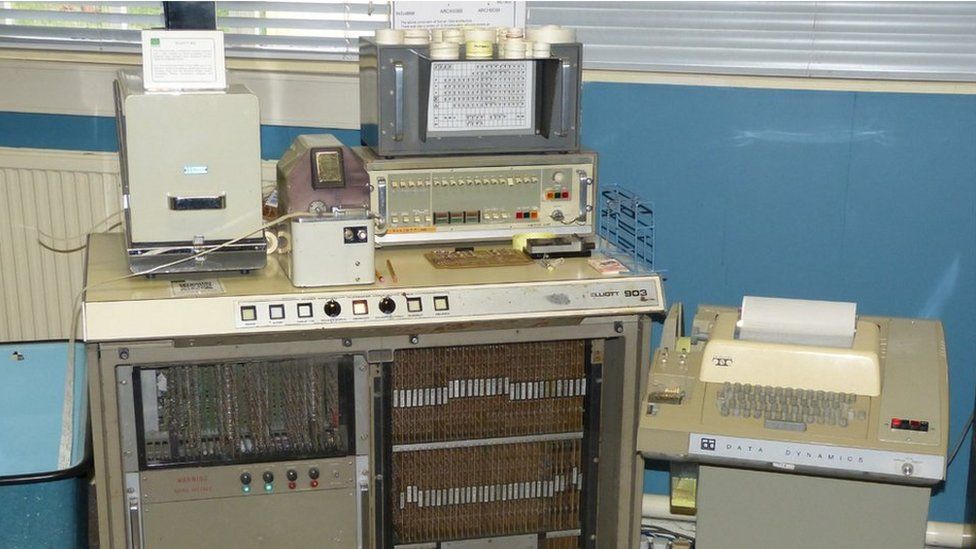Coding on tape - computer science A-level 1970s style
- Published

The chances of walking into a UK school without any computer equipment in today's world are practically zero.
But 45 years ago things were very different.
Staff at the AQA exam board have been trawling their archive and have found some early 1970s computer science papers, which highlight how much the subject has changed over the intervening period.
Back then, schools offering computer science A-level had to prove they had access to a computer, according to a syllabus from the time.
In 1970 computers were a rarity and pupils would have to visit machines in nearby universities or businesses, said AQA's computing qualifications manager Steven Kenny, because the cost of a school owning one was "prohibitive".
"They cost tens of thousands of pounds and were filing cabinet sized," he explained.
Paper tape
Students would write programs in longhand and if they were lucky, their school would have the facilities to punch the code on to paper tapes.
Otherwise the longhand notes would have to be sent off to be converted on to tape.
The students would then take the code with them when they visited the computer.
"They would spool the paper on to the computer and the code would appear on the screen if they had got it right. If it was wrong they would get an error message," said Mr Kenny.
This meant they would have to take it back to school, work out was wrong and correct it, he explained.
"It was often the same even at universities in those days."
Kevin Murrell, co-founder of The National Museum of Computing, said even a comma or a full stop out of place could mean a program would fail once it was put into the computer.
He described himself as "mortified" by the difficulty of the mathematics required by the 1971 A-level.
When he showed the paper to his staff, they "went white as a sheet", he told the BBC.
The paper required candidates to break everything down into binary or "machine code", which is "very hard work and not something that anyone would be asked to do today" he said.
"We write in languages that are akin to English which are converted into binary by the machine. For 99.9% of programmers, maths isn't an issue at all because modern computers do so much more."
In the 1970s machines were slow and students' access was so limited they had to be very precise about the programs they wrote.
Today's programmers can afford to be less precise as "the sheer brute force of modern computers gets you through".
Mr Murrell did O-level computer science in 1976 using a keyboard and printer connected by phone to an Open University computer.
"You would key in your program and it would run remotely at the OU. I can't tell you how exciting that was!"
Another generation
The price of computers gradually dropped with a Research Machines computer costing around £3,000 by the mid 1970s and a Commodore PET around £1,000 after that.
Another generation of coders learned their craft on machines like the Sinclair Spectrum and the BBC Micro, which appeared in the early 1980s.
Mr Kenny remembers the arrival of a computer at his inner city comprehensive school in 1979.
"Pupils had very limited access - only a few were allowed to use it."
All this had an effect on the exam questions.
"Because people didn't have access to computers, a lot of it had to be focused on theory.
"There was a big focus on logical and computational thinking, using flow charts and algorithms to break instructions down into the smallest logical steps for a computer to follow.
"The difference now is that there is a lot more creativity involved: for example designing apps for use in daily life."
However, one surprise was how many of the questions are still relevant, said Mr Kenny.
"About half the questions could probably be put into an A-level paper today with a bit more context."
The big differences were in questions focused on the practical use of computers - some of which now seem quaint.
For example candidates were asked to "Write an essay on the use of computers in one of the following (a) airlines (b) banking (c) local government or (d) wholesale trade".
Another question required them to prepare a flow chart to record 12,000 ticket sales between four destinations on the same railway line over a 30-day period.
"We wouldn't phrase this the same way or use the same example but some of the same processes would be needed by programmers today," said Mr Murrell.
Mr Kenny suggested today's equivalent question would be about "the internet of things", where, for example, a computerised fridge can detect when groceries are running low and order a delivery without the householder being involved.
'Geeky'
By the early 1980s people began to buy home computers and Mr Kenny admitted his younger self used to wonder why people would use them.
"They would have been game-players or enthusiastic coders - much more geeky than now," he suggests before adding that some people might have used them for "numbers and data", particularly home finances.
He adds: "It's easy for us to answer that question today because computers are everywhere. You have to remember that in 1971 not many people had even seen a computer, let alone used one."
- Published29 March 2016
- Published10 March 2016